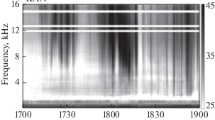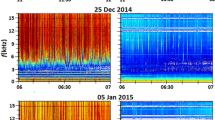Abstract
This paper discusses the spectral and temporal features of the 7-h daytime VLF noise emission burst in the frequency band of 1‒10 kHz observed on the Earth’s surface during the late recovery phase of a moderate magnetic storm (Kр = 5 and Dst ~ –80 nT) under nearly quiet space weather. These VLF emissions were recorded simultaneously at two auroral stations located at a geomagnetic latitude of ~64° MLAT and at a longitude distance of ~400 km from each other: Finnish Kannuslehto Station (KAN) and Russian Lovozero Observatory (LOZ). The dynamic VLF wave spectrum is considered at different time scales. During the development of the discussed daytime VLF burst, the noise emissions at below 3.5 kHz gradually turn into periodic (QP) emissions with a quasi-repetition of ~3 s. Having compared the directions of short isolated high-frequency (above 5 kHz) VLF signals (so-called “birds”) arriving at KAN and LOZ, we draw conclusions on the possible location and spatial dynamics of the exit area of emission from the ionosphere.






Similar content being viewed by others
REFERENCES
Bespalov, P.A., Self-modulation of plasma cyclotron maser radiation, Pis’ma Zh. Eksp. Teor. Fiz., 1981, vol. 33, no. 4, pp. 192–195.
Bespalov, P.A. and Koval’, L.N., Formation of the cyclotron instability periodic regimes in plasma magnetic mirrors, Fiz. Plazmy, 1982, vol. 8, no. 6, pp. 1136–1144.
Bespalov, P.A. and Trakhtengerts, V.Yu., On nonlinear oscillation processes in the Earth’s magnetosphere, Izv. Vyssh. Uchebn. Zaved., Radiofiz., 1976, vol. 19, nos. 5–6, pp. 801–811.
Bespalov, P.A. and Trakhtengerts, V.Y., The cyclotron instability in the Earth radiation belts, Rev. Plasma Phys., 1986, vol. 10, pp. 155–192.
Bespalov, P.A., Parrot, M., and Manninen, J., Short-period VLF emissions as solitary envelope waves in a magnetospheric plasma maser, J. Atmos. Sol.-Terr. Phys., 2010, vol. 72, pp. 1275–1281. https://doi.org/10.1016/j.jastp.2010.09.001
Bortnik, J., Thorne, R.M., and Meredith, N.P., Plasmaspheric hiss overview and relation to chorus, J. Atmos. Sol.-Terr. Phys., 2009, vol. 71, pp. 1636–1646. https://doi.org/10.1016/j.jastp.2009.03.023
Cornilleau-Wehrlin, N., Solomon, J., Korth, A., and Kremser, G., Generation mechanism of plasmaspheric ELF/VLF hiss: A statistical study from GEOS 1 data, J. Geophys. Res., 1993, vol. 98, pp. 21471–21480. https://doi.org/10.1029/93JA01919
Davis, T.N. and Sugiura, M., Auroral electrojet activity index AE and its universal time variations, J. Geophys. Res., 1966, vol. 71, pp. 785–801. https://doi.org/10.1029/JZ071i003p00785
Delport, B., Collier, A.B., Lichtenberger, J., Rodger, C.J., Parrot, M., Clilverd, M.A., and Friedel, R.H.W., Simultaneous observation of chorus and hiss near the plasmapause, J. Geophys. Res., 2012, A12218. https://doi.org/10.1029/2012JA017609
Dunckel, N. and Helliwell, R.A., Whistler mode emissions on the OGO 1 satellite, J. Geophys. Res., 1969, vol. 74, pp. 6371–6385. https://doi.org/10.1029/JA074i026p06371
Engebretson, M.J., Posch, J.L., Halford, A.J., Shelburne, G.A., Smith, A.J., Spasojevic, M., Inan, U.S., and Arnoldy, R.L., Latitudinal and seasonal variations of quasiperiodic and periodic VLF emissions in the outer magnetosphere, J. Geophys. Res., 2004, vol. 109, A05216. https://doi.org/10.1029/2003JA010335
Fedorenko, Y., Tereshchenko, E., Pilgaev, S., Grigoryev, V., and Blagoveshchenskaya, N., Polarization of ELF waves generated during “beating-wave” heating experiment near cutoff frequency of the Earth–ionosphere waveguide, Radio Sci., 2014, vol. 49, pp. 1254–1264. https://doi.org/10.1002/2013RS005336
Fedyakina, N.I., Noise storms in VLF-emissions and the Dst variation, in Nizkochastotnye signaly vo vneshnei ionosfere (Low-Frequency Signals in the Outer Ionosphere), Yakutsk: Yakutskii filial SO AN SSSR, 1976, pp. 59–64.
Gjerloev, J.W., The SuperMAG data processing technique, J. Geophys. Res., 2012, vol. 117, A09213. https://doi.org/10.1029/2012JA017683
Golden, D.I., Spasojevic, M., Li, W., and Nishimura, Y., Statistical modeling of plasmaspheric hiss amplitude using solar wind measurements and geomagnetic indices, Geophys. Res. Lett., 2012, vol. 39, L06103. https://doi.org/10.1029/2012GL051185
Hayakawa, M. and Sazhin, S.S., Mid-latitude and plasmaspheric hiss: A review, Planet. Space Sci., 1992, vol. 40, no. 10, pp. 1325–1338.
Helliwell, R.A., Whistler and Related Ionospheric Phenomena, Stanford: Stanford Univ. Press, 1965.
Kim, K.-C., Lee, D.-Y., and Shprits, Y., Dependence of plasmaspheric hiss on solar wind parameters and geomagnetic activity and modeling of its global distribution, J. Geophys. Res.: Space Phys., 2015, vol. 120, pp. 1153–1167. https://doi.org/10.1002/2014JA020687
Kleimenova, N.G., Troitskaya, V.A., and Vigneron, J., The relationship of midlatitude VLF emissions with geomagnetic activity, Geomagn. Aeron., 1968, vol. 8, no. 1, pp. 529–533.
LaBelle, J. and Treumann, R., Auroral radio emissions. 1. Hisses, roars, and bursts, Space Sci. Rev., 2002, vol. 101, no. 3, pp. 295–440.
Manninen, J., Some aspects of ELF–VLF emissions in geophysical research, PhD Thesis, Sodankylä, Finland: Oulu University, 2005. http://www.sgo.fi/Publications/SGO/thesis/ManninenJyrki.pdf.
Manninen, J., Kleimenova, N.G., and Kozyreva, O.V., Daytime VLF emissions at the Sodankylä Observatory (L ~ 5.3) at the front of high-speed solar wind streams, Geomagn. Aeron. (Engl. Transl.), 2013, vol. 53, no. 3, pp. 298–306. https://doi.org/10.1134/S0016793213030109
Manninen, J., Demekhov, A.G., Titova, E.E., Kozlovsky, A.E., and Pasmanik, D.L., Quasi-periodic VLF emissions with short-period modulation and their relationship to whistlers: A case study, J. Geophys. Res., 2014, vol. 119, no. 5, pp. 3544–3557. https://doi.org/10.1002/2013JA019743
Manninen, J., Kleimenova, N.G., Kozlovsky, A., Kornilov, I.A., Gromova, L.I., Fedorenko, Yu.V., and Turunen, T., Strange VLF bursts in Northern Scandinavia: Case study of the afternoon “mushroom-like” hiss on 8 December 2013, Ann. Geophys., 2015, vol. 33, pp. 991–995. https://doi.org/10.5194/angeo-33-991-2015
Manninen, J., Turunen, T., Kleimenova, N., Rycroft, M., Gromova, L., and Sirviö, I., Unusually high frequency natural VLF radio emissions observed during daytime in Northern Finland, Environ. Res. Lett., 2016, vol. 11, id 124006. https://doi.org/10.1088/1748-9326/11/12/124006
Manninen, J., Turunen, T., Kleimenova, N.G., Gromova, L.I., and Kozlovskii, A.E., A new type of daytime high-frequency VLF emissions at auroral latitudes (“bird emissions”), Geomagn. Aeron. (Engl. Transl.), 2017, vol. 57, no. 1, pp. 32–39. https://doi.org/10.1134/S0016793217010091
Meredith, N.P., Horne, R.B., Clilverd, M.A., Horsfall, D., Thorne, R.M., and Anderson, R.R., Origins of plasmaspheric hiss, J. Geophys. Res., 2006, vol. 111, A09217. https://doi.org/10.1029/2006JA011707
Němec, F., Santolík, O., Parrot, M., Pickett, J.S., Hayosh, M., and Cornilleau-Wehrlin, N., Conjugate observations of quasi-periodic emissions by Cluster and DEMETER spacecraft, J. Geophys. Res.: Space Phys., 2013, vol. 118, no. 1, pp. 198–208. https://doi.org/10.1029/2012JA018380
Newell, P.T. and Gjerloev, J.W., Evaluation of SuperMAG auroral electrojet indices as indicators of substorms and auroral power, J. Geophys. Res., 2011, vol. 116, A12211. https://doi.org/10.1029/2011JA016779
Nikitenko, A.S., Lebed’, O.M., and Fedorenko, Yu.V., The first results of localization of natural ELF/VLF emissions at high latitudes according to ground-based observation data, in Trudy 41-go seminara “Fizika avroral’nykh yavlenii” (Proceedings of the 41th Seminar “Physics of Auroral Phenomena”), Apatity, 2018, pp. 61–65. https://doi.org/10.25702/KSC.2588-0039.2018.41.61-65.
Ohya, H., Shiokawa, K., and Miyoshi, Y., Daytime tweek atmospherics, J. Geophys. Res.: Space Phys., 2015, vol. 120, no. 1, pp. 654–665. https://doi.org/10.1002/2014JA020375
Pilgaev, S.V., Larchenko, A.V., Filatov, M.V., Fedorenko, Yu.V., and Lebed, O.M., A function generator for calibration of electromagnetic-field recorders, Instrum. Exp. Tech., 2018, vol. 61, no. 6, pp. 809–814. https://doi.org/10.1134/S0020441218060106
Raspopov, O.M. and Kleimenova, N.G., Vozmushcheniya elektromagnitnogo polya Zemli (Disturbances in the Earth’s Electromagnetic Field), vol. 3: ONCh izlucheniya (VLF Emissions), Leningrad: LGU, 1977.
Rycroft, M.J., VLF emissions in the magnetosphere, Radio Sci., 1972, vol. 7, pp. 811–830. https://doi.org/10.1029/RS007i008p00811
Rytov, S.M., Vvedenie v statisticheskuyu radiofiziku (Introduction to Statistical Radiophysics), vol. 1: Sluchainye protsessy (Random Processes), Moscow: Nauka, 1966.
Santolík, O. and Chum, J., The origin of plasmaspheric hiss, Science, 2009, vol. 324, no. 5928, pp. 729–730. https://doi.org/10.1126/science.1172878
Santolík, O., Parrot, M., Storey, L.R.O., Pickett, J.S., and Gurnett, D.A., Propagation analysis of plasmaspheric hiss using Polar PWI measurements, Geophys. Res. Lett., 2001, vol. 28, no. 6, pp. 1127–1130. https://doi.org/10.1029/2000GL012239
Smith, E.J., Frandsen, A.M.A., Tsurutani, B.T., Thorne, R.M., and Chan, K.W., Plasmaspheric hiss intensity variations during magnetic storms, J. Geophys. Res.,1974, vol. 79, no. 16, pp. 2507–2510. https://doi.org/10.1029/JA079i016p02507
Storey, L.R.O., Lefeuvre, F., Parrot, M., Cairó, L., and Anderson, R.R., Initial survey of the wave distribution functions for plasmaspheric hiss observed by ISEE 1, J. Geophys. Res., 1991, no. A11, pp. 19469–19489. https://doi.org/10.1029/91JA01828
Summers, D., Omura, Y., Nakamura, S., and Kletzing, C.A., Fine structure of plasmaspheric hiss, J. Geophys. Res.: Space Phys., 2014, vol. 119, pp. 9134–9149. https://doi.org/10.1002/2014JA020437
Tanskanen, E.I., A comprehensive high-throughput analysis of substorms observed by image magnetometer network: Years 1993–2003 examined, J. Geophys. Res., 2009, vol. 114, A05204. https://doi.org/10.1029/2008JA013682
Thorne, R.M., Smith, E.J., Burton, R.K., and Holzer, R.E., Plasmaspheric hiss, J. Geophys. Res., 1973, vol. 78, pp. 1581–1596. https://doi.org/10.1029/JA078i010p01581
Thorne, R.M., Church, S.R., and Gorney, D.J., On the origin of the plasmaspheric hiss: The importance of wave propagation and the plasmapause, J. Geophys. Res., 1979, vol. 84, pp. 5241–5247. https://doi.org/10.1029/JA084iA09p05241
Titova, E.E., Kozelov, B.V., Demekhov, A.G., Manninen, J., Santolik, O., Kletzing, C.A., and Reeves, G., Identification of the source of quasiperiodic VLF emissions using ground-based and Van Allen Probes satellite observations, Geophys. Res. Lett., 2015, vol. 42, pp. 6137–6145. https://doi.org/10.1002/2015GL064911
Trakhtengerts, V.Y. and Rycroft, M.J., Whistler and Alfvén Mode Cyclotron Masers in Space, Cambridge: Cambridge Univ. Press, 2008; Moscow: Fizmatlit, 2011.
Trakhtengerts, V.Y., Rycroft, M.J., and Demekhov, A.G., Interrelation of noise-like and discrete ELF/VLF emissions generated by cyclotron interactions, J. Geophys. Res., 1996, vol. 101, no. A6, pp. 13293–13303. https://doi.org/10.1029/95JA03515
Tsurutani, B.T., Falkowski, B.J., Pickett, J.S., Santolik, O., and Lakhina, G.S., Plasmaspheric hiss properties: observations from polar, J. Geophys. Res.: Space Phys., 2015, vol. 120, pp. 414–431. https://doi.org/10.1002/2014JA020518
Vershinin, E.F. and Ponomarev, E.A., On the classification of continuous VLF radio emission of the upper atmosphere, in Zemnoi magnetizm, polyarnye siyaniya i ul’tranizkochastotnoe izluchenie (Terrestrial Magnetism, Polar Auroras, and VLF Emission), 1966, vol. 1, pp. 35–44.
Vershinin, E.F., Gorshkov, Yu.N., and Ponomarev, E.A., The characteristics and conditions for the emergence of VLF emission bursts of the noise storm class, Issled. Geomagn. Aeron. Fiz. Solntsa, 1974, vol. 30, pp. 3–9.
Yearby, K.H. and Smith, A.J., The polarization of whistlers received on the ground near L = 4, J. Atmos. Terr. Phys., 1994, vol. 56, pp. 1499–1512. https://doi.org/10.1016/0021-9169(94)90117-1
Author information
Authors and Affiliations
Corresponding authors
Additional information
Translated by E. Maslennikova
Rights and permissions
About this article
Cite this article
Manninen, J., Kleimenova, N.G., Gromova, L.I. et al. Daytime VLF Emissions during the Magnetic Storm Recovery Phase: the Event of January 5, 2015. Geomagn. Aeron. 60, 301–310 (2020). https://doi.org/10.1134/S0016793220030111
Received:
Revised:
Accepted:
Published:
Issue Date:
DOI: https://doi.org/10.1134/S0016793220030111




